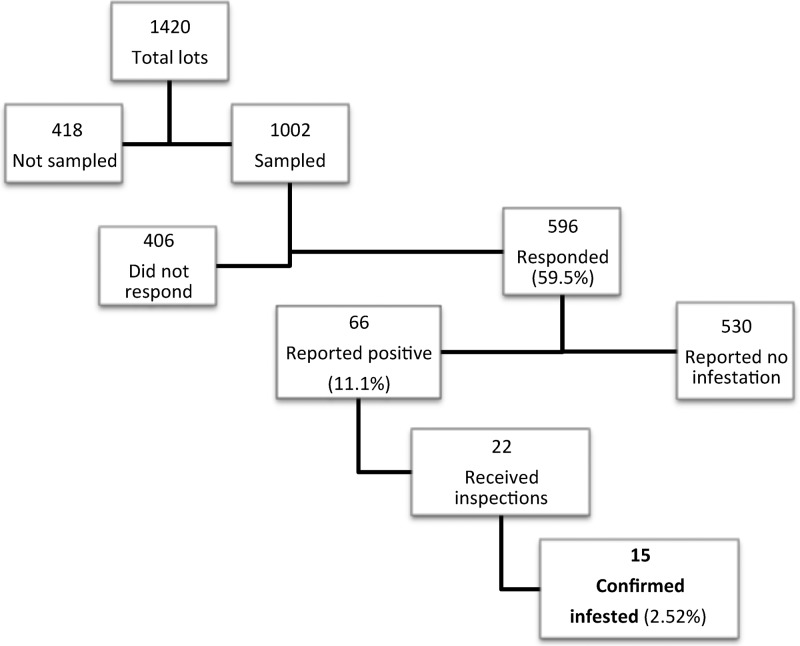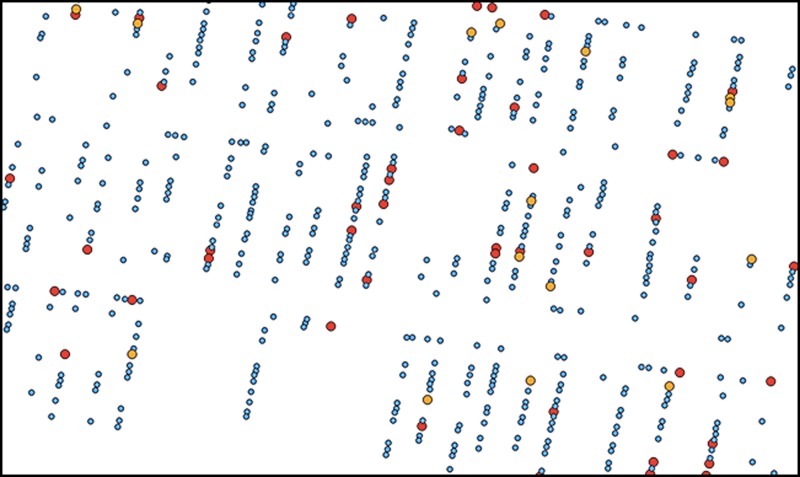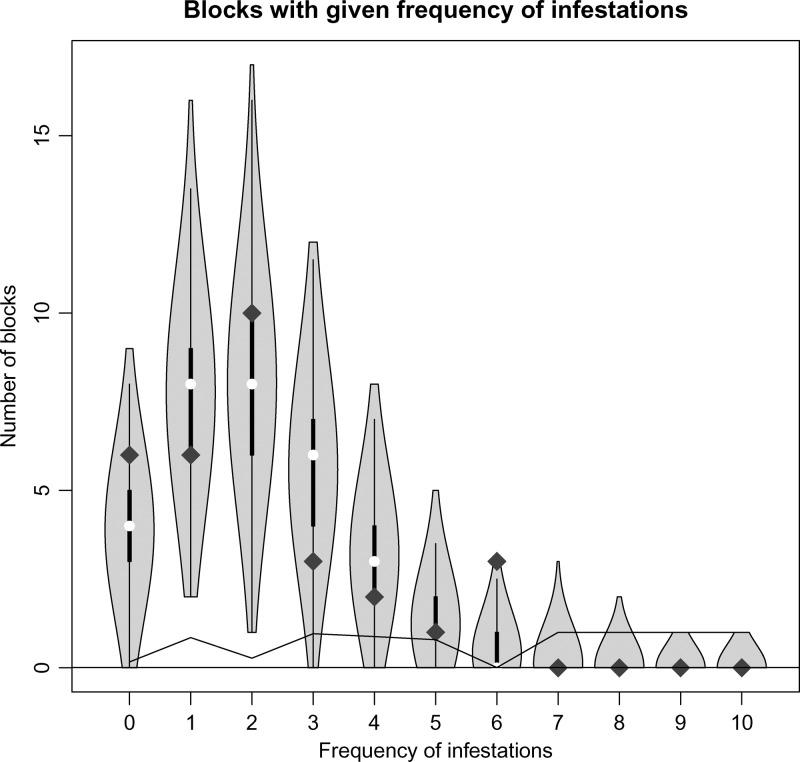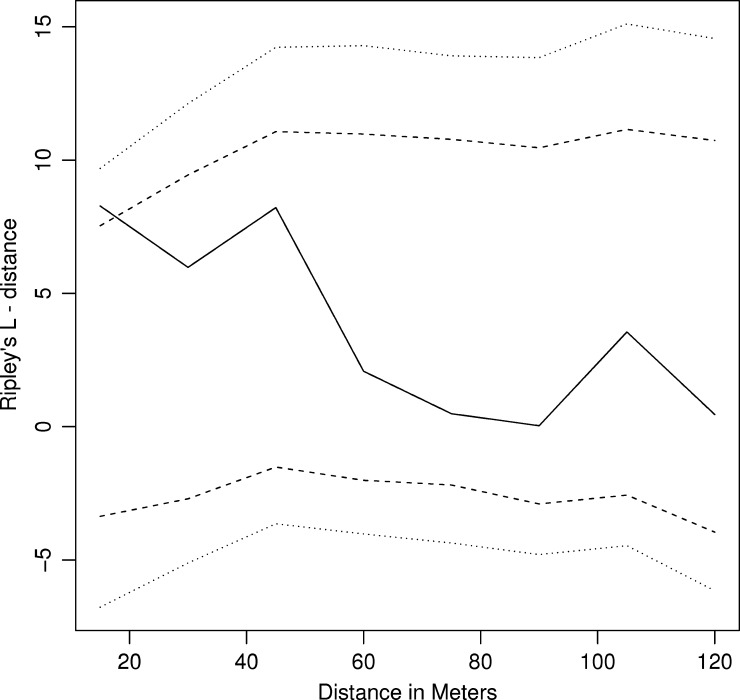Abstract
We conducted a door-to-door survey in a residential census tract of Philadelphia to estimate the prevalence and spatial patterns of recent bed bug infestations. We interviewed 596 residents, of whom 66 (11.1%) reported recent bed bug infestations. We confirmed current infestations in a subset of 15 (68.2%) of 22 inspected households. Most residents reported that their infestation began within the past year (2012–2013). We found no correlation between property value and infestation status. Spatial analyses showed significant clustering of bed bug infestations only at fine scales, suggesting limited active dispersal of the insects. Residents used a large variety of treatment methods to eliminate bed bugs, but only 48.1% reported success. Our results provide a prevalence estimate of recent bed bug infestations and highlight the importance of passive rather than active dispersal of bed bugs even among dense urban row homes.
Introduction
Bed bugs (Cimex lectularius) have reestablished themselves as an urban pest problem in the United States and worldwide, including the tropics, over the past decade.1–4 This hematophagous insect affects a wide range of communities and often constitutes a significant public health problem.2 Bed bug bites are known to cause various forms of cutaneous reactions, including minor itching, severe inflammation, and secondary infections.5 In addition, bed bugs can be a cause of mental distress and overall physical discomfort.2 Their cryptic nature and increasing resistance to a large variety of insecticides makes them difficult to detect and even more difficult to eliminate.6 In addition, the high cost and limited effectiveness of treatment methods may restrict community efforts to exterminate them,7 and may create an economic burden on affected communities and local governments.8
Current evidence suggests numerous pathways for bed bug dispersal. Bed bugs can be spread passively, predominantly by human movement.9 Such passive spread involves the transport of insects on hosts and their effects, including clothing, luggage, and furniture. Bed bugs can also spread actively from site to site. Active spreading has been observed in genetic studies showing high relatedness among bed bugs within a high-rise building, which suggests that bed bugs may crawl between apartment units via shared infrastructure.10 Our study aims to assess these bed bug dispersal patterns in urban row homes of one residential neighborhood.
Despite growing economic and health concerns surrounding the re-emergence of bed bugs, there has not yet been a systematic effort to study infestations in urban communities. Control of bed bugs in cities may be especially difficult because the dense urban environment may facilitate their spread.11 Understanding the extent and spatial patterns of urban infestations is critical to the eventual design of effective strategies for their control.12 In this study, we performed a survey in a residential census tract of Philadelphia, Pennsylvania, to better estimate the prevalence of bed bugs in the urban environment, and to assess spatial patterns of bed bug infestation.
Methods
Study area and population.
We surveyed a rectangular area of approximately 0.0595 miles2 (0.154 km2) encompassing one census tract in South Philadelphia.13 There were 1,420 lots in the census tract. The area was primarily residential.14 Housing consisted mostly of two- to three-story residential row homes with some multifamily homes. The total population reported in 2011 was 2,920, and the predominant ethnicities were African American, White, and Asian, respectively.15 The median annual household income in 2011 was $22,014.16 Migration into the census tract was frequent; an estimated 317 (10.9%) of 2,920 persons moved into the tract during 2010–2011. Most (85.2%) persons who moved into the tract came from elsewhere in Philadelphia County; 7.57% relocated from other counties in Pennsylvania; 3.79% relocated from another state, and 3.47% relocated from another country.16
Study design and sampling method.
We used a citywide zoning map14 to categorize each property in the census tract according to zoning type. To meet the criteria for inclusion in our sample, a property had to be residential (a house or apartment complex) and contain a finished building unit. Lots that were for commercial use, unfinished, or uninhabited were excluded from the study.
All households in this study were sampled during May–July 2013. We made up to three visits to each household. On the first visit, we knocked and left flyers describing the study and listing the contact information of the investigators. We varied the time of visits such that each household was visited at least once in the morning and once in the evening. If the resident responded on any visit, we inquired about the past and current infestation status of the house. If the resident reported having a bed bug infestation, we conducted a structured interview to assess previous treatment history and potential sources of infestation (The questionnaire is provided in the supplemental materials). We refer to these households as reported positive throughout the report. Households that did not report positive did not participate further in the study.
We offered free inspections to reported positive households and, as added incentive for participation, entrance into a drawing for free treatment if a current infestation was confirmed. We refer to households that agreed to inspections and in which we found live bed bugs as confirmed infested (Figure 1). All inspections were performed by study staff experienced in bed bug detection. In households where we did not observe evidence of bed bugs during inspection, we left ClimbUp© interceptors (Bed Bug Supply, Coral Springs, FL) under bedposts and examined them for insects one week later. The interceptor is a plastic dish with a center division, the walls of which are coated with talcum powder that prevents bed bugs from escaping after they fall into the outer ring. Protocols were reviewed and approved by the Institutional Review Board of the University of Pennsylvania (protocol #817710).
Figure 1.
Participation rate, infestation reports, and confirmed infestations among sampled households in a census tract of Philadelphia, Pennsylvania. Results obtained from a door-to-door survey conducted May–July 2013.
Statistical analysis.
We linked economic data from the Philadelphia Office of Property Assessment17 to each household in the census tract. Using this information, we compared covariates between the responding and non-responding households to assess any response bias in our sample. We also compared covariates between households that reported positive and those that did not report positive. The same analyses were performed comparing the confirmed infested households to those with only a past infestation history to assess if any economic or environmental factors contribute to the maintenance of infestation. We used a structured questionnaire to assess differences in types of treatment methods, costs, and other factors between those that perceived their efforts to be successful and those that did not. We used the Kruskal-Wallis and Fisher's exact tests to compare continuous and binary covariates among groups, respectively.
We performed four analyses to assess patterns of spatial distribution of reported positive households in the study area. To check if infested households were more clustered on particular city blocks, we performed a random labeling simulation18 test in which we randomly distributed the observed number of infested houses across the blocks in our study area. This simulation was repeated 1,000 times, after which we plotted a distribution of the expected number of blocks with a given number of infestations based on chance. Random simulation results were compared with the observed data to determine the presence of any significant clustering of infestation. Because this method is limited to assessing correlation within city blocks, a Moran's I and a stratified Moran's I test for autocorrelation19 were performed. The latter test takes into account the effects of city streets on spatial patterns. The Ripley's L Function for multi-distance spatial cluster analysis was also applied.20–22 All analyses were performed in R.23
Results
Survey results.
A total of 1,002 of the 1,420 lots in the census tract met our sampling criteria (Figure 2). Of these lots, 596 (59.5%) provided a response to either the door-to-door survey or to the recruitment flyer. Among the 596 respondents, 66 (11.1%) reported having bed bugs recently in their residence and were classified as reported positive. Of these 66 positive responders, 59 (89.4%) participated in our questionnaire and 22 (33.3%) agreed to a house inspection by our field team. Most persons who did not participate in inspections believed that they no longer had an infestation. Bed bugs were collected from 15 of the 22 inspected households.
Figure 2.
Detail of a map of the studied census tract in Philadelphia, Pennsylvania (May–July 2013) showing spatial distribution of responses. Landmarks have been removed. Blue circles = reported negative for bed bug infestation; orange circles = reported positive for bed bug infestation; Red circles = confirmed bed bug infestation during inspection.
Correlates of infestations.
The mean property value of houses in our sample was $103,300.17 The mean property values of non-responding houses versus responding houses were not significantly different ($105,600 versus $101,800; P < 0.33, by Kruskal-Wallis test). Among the responding households, those that reported positive for bed bugs did not have significantly different mean property values from those that reported negative for bed bugs ($99,020 versus $101,800; P < 0.66). The mean property value of confirmed infested households was $14,440 lower than that of non-confirmed households that reported having bed bugs in the recent past ($87,860 versus $102,300), many of which had made efforts to control their infestations. Although this difference was large, it was not significant by the Kruskal Wallis test (P < 0.14) probably because of the limited sample size of confirmed infested units.
Nearly all houses in our sample (923 of 1002) were single-family residential houses; the remaining houses were mainly multi-family apartments. The single-family houses had a relative response rate of 60.6% compared with 47.8% for multi-family apartments, but this difference was not significant (P < 0.80, by Fisher's exact test). Single-family houses did not have a significantly lower rate of infestation reports than multi-family apartments (10.9% versus 15.6%; P < 0.39, by Fisher's exact test).
Temporal trends.
Bed bugs have been in the study site for several years. One resident reported detecting bed bugs as early as 2005, but the prevalence of infestations in the area has clearly increased since their resurgence in the early 2000s. Most residents who experienced a bed bug infestation since their resurgence reported that their infestations began within the past year (81.1%, 53 of 59). Furthermore, just more than half (50.9%) of the affected residents reported that their infestations began within the previous six months.
Treatment.
Of the 59 reported positive households that completed our survey, 52 (86.4%) had attempted some form of treatment before our study and showed varying degrees of success. Thirty-six (69.2%) of these 52 households attempted to exterminate the insects without any professional help. Sixteen (30.8%) households contracted a person or company for extermination services. Thirteen (81.3%) of these households seeking professional help hired independent contractors, and the other 3 (18.8%) hired an acquaintance. Of the 16 households that sought extermination services, 10 (62.5%) had also attempted some form of self-treatment, leaving 6 (37.5%) who relied solely on professional treatment. Households that only hired professionals reported spending on average $611.10 (range = $100–$1,200. Those households that only self-treated reported spending on average $229.10 (range = $10–$800. Households that self-treated and hired professionals reported spending on average $550 (range = $100–$1,000).
A wide variety of self-treatment methods were reported. Of the 46 households that attempted some type of self-treatment, 33 (71.7%) applied over-the-counter insecticides and 15 (32.6%) cleaned their houses by applying household cleaning products, washing, or vacuuming. Five (10.9%) used non-conventional treatments, a few of which were potentially hazardous. In one such case, the resident washed his entire house with gasoline and oil. In addition, 5 (10.9%) used bed bug mattress covers, 3 (6.52%) used alcohol, 3 (6.52%) also used diatomaceous earth, and 1 (2.17%) used bed bug bombs.
Residents reported varying levels of treatment success. Of the 36 residents who only attempted treatment on their own, 16 (44.4%) reported being successful, and 9 (56.3%) of the 16 who paid for extermination services reported success in their treatment.
Spatial analysis.
Results obtained from the random labeling simulation test show no significant spatial clustering of reported bed bug infestations at the scale of the city block because the observed frequencies of infestations per block fell within the interval of frequencies expected by chance (Figure 3). However, the Ripley's L (Figure 4) and Moran's I tests detected clustering on fine spatial scales of less than 15 meters, a distance that corresponds to immediately adjacent homes.
Figure 3.
Violin plot for the assessment of spatial clustering of reported bed bug infestations on city blocks. Philadelphia, Pennsylvania, May–July of 2013. Black bar = first–third quantiles; white dot = median; shaded area = distribution of expected number of blocks with given infestations; diamond dot = observed number of blocks with given infestations; solid black line = Observed P value.
Figure 4.
Ripley's L function. Analysis of spatial clustering of reported infestations among respondents in a census tract of Philadelphia, Pennsylvania, May–July of 2013. Solid black line = observed clustering; area between dashed lines = 95% confidence interval; area between dotted lines = 95% confidence interval with Bonferroni correction (99.375% of replicates).
Discussion
The recent resurgence of bed bugs in urban neighborhoods has created an especially complex public health problem. Data relevant to the extent of bed bug infestations has, until now, been limited to records maintained by large pest companies,24 health agencies,25 and Internet databases.26 These data sources, although helpful, are not representative of entire residential neighborhoods. Our study provides a door-to-door assessment of the bed bug epidemic in an urban neighborhood. We found that a total of 11.1% of the interviewed households reported experiencing problems with bed bugs since their resurgence in the area, a far higher proportion than we expected.
We have reasons to suspect that the 11.1% figure might be an overestimate. First, our study was susceptible to participation bias because households affected with bed bugs may have been more likely to respond to the study flyers. The degree of participation bias would be only moderate, however, because only a handful of the 596 responding households responded to the flyer alone, and most were interviewed on their front stoop. Second, it is possible that our data contain some false-positive reports. Residents commonly confuse bed bugs with other household insects such as immature cockroaches, fleas, or spider beetles.27 Conversely, there may be reason to suspect that 11.1% is an underestimate. The stigma surrounding bed bugs may cause some infested households to not report their infestations.28 In addition, because of the cryptic nature of the insects and varying response to bites by humans,29 residents may be unaware of an existing infestation.2 In a recent study of bed bug infestations in a high-rise building, only half of the residents with infested households knew about their infestation.10 The imperfect sensitivity of homeowners to infestations could have a measurable impact on prevalence estimates. Our study was also limited by our inability to accurately measure the size of bed bug infestations, and our reliance on public data sources for some covariate information. By using public sources of data, we were able to gather covariate information outside of the structured interview. However, we were not able to obtain sufficient data on home ownership.
We found evidence of spatial clustering of infestations only at fine spatial scales. Previous studies have noted the intimate connections between row homes including party walls, shared piping, and joist holes.9,30,31 Such connections may facilitate the active dispersal of insects between adjacent houses. The lack of significant clustering on city blocks, however, suggests that the active movement of insects between houses is limited, and the presence of insects throughout the study area suggests that the rate of active dispersal is overshadowed by the rate of passive dispersal. The predominance of passive dispersal bodes well for the possibility of controlling the insects because they are not moving quickly between neighboring houses and are thereby easier to contain. Conversely, controlling passively dispersing insects is challenging because control efforts cannot be easily targeted to spatial hotspots of infestations. Targeted control based on social networks for residents could potentially be effective, but such targeting would likely be difficult to implement.
By conducting a door-to-door survey across residential row homes, we were able to describe patterns in recent bed bug infestations in a census tract of Philadelphia. The high reported rate of recent infestations (11.1%) and the low perceived success of treatment methods (48%) emphasize the difficulty of managing bed bugs in urban and other complex environments. In low-income communities especially, the cost of bed bug treatment can be an important barrier to control. The lack of cheaper and more effective treatment methods makes the current bed bug epidemic difficult to curtail and even more difficult to eliminate even from relatively small geographic areas.
Supplementary Material
ACKNOWLEDGMENTS
We thank the residents of our study area, John Barnum, Michelle Niedermeier, Rhonda Griffen, and Changlu Wang for their help and advice; and Susan McKnight for donating ClimbUp interceptors.
Footnotes
Financial support: This study was supported by the University of Pennsylvania University Research Fund.
Authors' addresses: Yage Yu, Dylan M. Tracy, Corentin M. Barbu, and Michael Z. Levy, Department of Biostatistics and Epidemiology, University of Pennsylvania Perelman School of Medicine, Philadelphia, PA, E-mails: yawu@sas.upenn.edu, tradylan@sas.upenn.edu, corentin.barbu@gmail.com, and mzlevy@mail.med.upenn.edu. Alexis M. Barbarin, Department of Entomology, North Carolina State University, Raleigh, NC, E-mail: alexis_barbarin@ncsu.edu.
References
- 1.Potter MF, Rosenberg B, Henriksen M. Bugs without Borders–Executive Summary: Defining the Global Bed Bug Rresurgence. Fairfax, VA: National Pest Management Association, Inc; 2010. [Google Scholar]
- 2.Anderson AL, Leffler K. Bedbug infestations in the news: a picture of an emerging public health problem in the united states. J Environ Health. 2008;70:24–27. 52–53. [PubMed] [Google Scholar]
- 3.Doggett SL, Geary MJ, Russell RC. The resurgence of bed bugs in australia: with notes on their ecology and control. EH-Aust Institue Of Environ Health. 2004;4:30–38. [Google Scholar]
- 4.Nascimento L, Marques T, Barata J, Robinson W, de Carvalho Campos A. Bed bug (heteroptera, cimicidae) infestations in the metropolitan region of São Paulo, Brazil. International Conference on Urban Pests. 2011;7:311–314. [Google Scholar]
- 5.Goddard J. Bed bugs (Cimex lectularius) and clinical consequences of their bites. JAMA. 2009;301:1358–1366. doi: 10.1001/jama.2009.405. [DOI] [PubMed] [Google Scholar]
- 6.Romero A, Potter MF, Potter DA, Haynes KF. Insecticide resistance in the bed bug: a factor in the pest's sudden resurgence? J Med Entomol. 2007;44:175–178. doi: 10.1603/0022-2585(2007)44[175:IRITBB]2.0.CO;2. [DOI] [PubMed] [Google Scholar]
- 7.Wang C, Gibb T, Bennett GW. Evaluation of two least toxic integrated pest management programs for managing bed bugs (Heteroptera: Cimicidae) with discussion of a bed bug intercepting device. J Med Entomol. 2009;46:566–571. doi: 10.1603/033.046.0322. [DOI] [PubMed] [Google Scholar]
- 8.Wong M, Vaidyanathan N, Vaidyanathan R. Strategies for housing and other housing providers. Journal of Housing and Community Development. May–June. 2013:20–28. [Google Scholar]
- 9.Boase C. Bedbugs: back from the brink. Pestic Outlook. 2001;12:159–162. [Google Scholar]
- 10.Wang C, Saltzmann K, Chin E, Bennett GW, Gibb T. Characteristics of cimex lectularius (hemiptera: Cimicidae), infestation and dispersal in a high-rise apartment building. J Econ Entomol. 2010;103:172–177. doi: 10.1603/ec09230. [DOI] [PubMed] [Google Scholar]
- 11.Hwang SW, Svoboda TJ, Jong DJ, Kabasele KJ, Gogosis E. Bed bug infestations in an urban enviornment. Emerg Infect Dis. 2005;11:533–538. doi: 10.3201/eid1104.041126. [DOI] [PMC free article] [PubMed] [Google Scholar]
- 12.Levy MZ, Malaga Chavez FS, Cornejo del Carpio JG, Vilhena DA, McKenzie FE, Plotkin JB. Rational spatio-temporal strategies for controlling a Chagas disease vector in urban environments. J R Soc Interface. 2010;7:18. doi: 10.1098/rsif.2009.0479. [DOI] [PMC free article] [PubMed] [Google Scholar]
- 13.Google Earth. Mountain View, CA: Google Inc. 2013; Version 7.1.1.1888. [Google Scholar]
- 14.City of Philadelphia . City of Philadelphia Map. http://www.phila.gov/Map#id=757bbd2d07704a9bb684a1e88ca681c9 Available at. Accessed May 2013. [Google Scholar]
- 15.Total Population By Race/Ethnicity by Census Tract . City of Philadelphia: City Planning. http://www.phila.gov/CityPlanning/resources/Data/2010_Race_ DataDEC_10_PL_GCTPL1.CY07.xlt December 2010. Available at. Accessed 2013. [Google Scholar]
- 16.United States Census Bureau . American Fact Finder. 2012. http://factfinder2.census.gov/faces/nav/jsf/pages/searchresults.xhtml?refresh=t Available at. Accessed July 2013. [Google Scholar]
- 17.City of Philadelphia . Property Assessment Data. City of Philadelphia. 2013. Office of Property Assessment.http://www.phila.gov/OPA/Assessments/Pages/2012Assessment.aspx Available at. Accessed July 2013. [Google Scholar]
- 18.Waller LA, Gotway CA. Applied Spatial Statistics for Public Health Data. Hoboken, NJ: John Wiley & Sons; 2004. [Google Scholar]
- 19.Barbu CM, Hong A, Manne JM, Small DS, Quintanilla Calderón JE, Sethuraman K, Quispe-Machaca V, Ancca-Juárez J, Cornejo del Carpio JG, Malaga Chavez FS, Náquira C, Levy MZ. The effects of city streets on an urban disease vector. PLOS Comput Biol. 2013;9:e1002801. doi: 10.1371/journal.pcbi.1002801. [DOI] [PMC free article] [PubMed] [Google Scholar]
- 20.Baddeley A. Analysing Spatial Point Patterns in R. Clayton South, Victoria, Australia: CSIRO; and Perth: University of Western Australia; 2008. [Google Scholar]
- 21.Haase P. Spatial pattern analysis in ecology based on Ripley's k-function: introduction and methods of edge correction. J Veg Sci. 1995;6:575–582. [Google Scholar]
- 22.Ripley B. Tests of randomness for spatial point patterns. J Roy Stat Soc B Met. 1979;41:368–374. [Google Scholar]
- 23.R Version 3.0.1. http://www.r-project.org/ R Develop Core Team: 2013. Available at. Accessed March 24, 2014.
- 24.Teminix Bed Bug Tracker. Terminix Commercial. http://www.terminixcommercial.com/BedBugSolutions/BedBugTracker Available at. Accessed December 2013. [Google Scholar]
- 25.Mabud T, Barbarin AM, Barbu CM, Levy KH, Edinger J, Levy MZ. Spatial and temporal patterns in Cimex lectularius (Hemiptera: Cimicidae) reporting in Philadelphia, PA. J Med Entomol. 2014;51:50–54. doi: 10.1603/me13120. [DOI] [PMC free article] [PubMed] [Google Scholar]
- 26.Latests Bed Bug Reports Bed Bug Reports. 2013 http://www.bedbugreports.com/city/pa-philadelphia Available at. Accessed 2013. [Google Scholar]
- 27.The Pennsylvania Integrated Pest Management Program . Preventing and Getting Rid of Bed Bugs Safely. University Park, PA: Pennsylvania State University; [Google Scholar]
- 28.Davies T, Field L, Williamson M. The re-emergence of the bed bug as a nuisance pest: implications of resistance to the pyrethroid insecticides. Med Vet Entomol. 2012;26:241–254. doi: 10.1111/j.1365-2915.2011.01006.x. [DOI] [PubMed] [Google Scholar]
- 29.Delaunay P, Blanc V, Del Giudice P, Levy-Bencheton A, Chosidow O, Marty P, Brouqui P. Bedbugs and infectious diseases. Clin Infect Dis. 2011;52:200–210. doi: 10.1093/cid/ciq102. [DOI] [PMC free article] [PubMed] [Google Scholar]
- 30.Fantham HB, Stephens JW, Theobald FV. The Animal Parasites of Man. New York: William Wood and Company; 1916. [Google Scholar]
- 31.Murtagh WJ. The Philadelphia row house. Journal of the Society of Architectural Historians. 1957;16:8–13. [Google Scholar]
Associated Data
This section collects any data citations, data availability statements, or supplementary materials included in this article.






